Friday, 17 June 2011: Vienne to Serrières, through Rhône, Isère, Ardèche, and Drôme
Written 11 July 2011
Friday morning, we were faced with a difficulty. Our Friday-night dinner and lodging, the Hôtel Schaeffer in Serrières, was the one that wanted to know just when we going to arrive, and I had been at a loss to tell them. They finally asked that we telephone in the course of the day to give them an estimate. Unfortunately, because cell phones are so prevalent in France—everyone has one but us—pay phones have largely disappeared, so the best solution I could come up with was to phone them from our hotel in before checking out, ask them how long it should take us to drive from there, promise an ETA based on that information, then drive straight there, drop off our stuff, and do our sight-seeing after. Also unfortunately, I tried to call three times that morning but got only busy signals. Okay, at least I could say I tried.
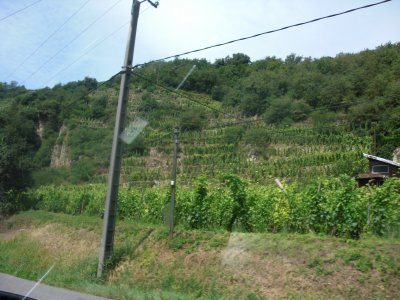
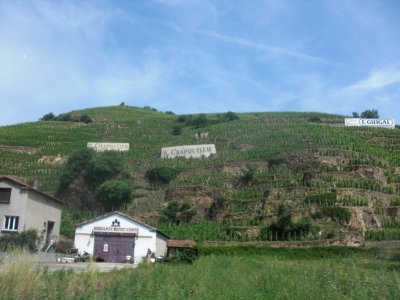 One of the things the tourist office had provided was a map of villages in the Côtes du Rhône wine area. As I've no doubt explained before, "côtes" in this sense means hillsides—the Côtes du Rhône are simply the hillsides facing the Rhône River from about Vienne to about Valence, mostly on the west side, but some on the east side as well. The whole region is therefore very long and skinny, and because Vienne and Serrières are both on the river, our route lay right along the route indicated on the map. We therefore fetched the car from the parking garage, packed it up, and commenced sight-seeing southward.
One of the things the tourist office had provided was a map of villages in the Côtes du Rhône wine area. As I've no doubt explained before, "côtes" in this sense means hillsides—the Côtes du Rhône are simply the hillsides facing the Rhône River from about Vienne to about Valence, mostly on the west side, but some on the east side as well. The whole region is therefore very long and skinny, and because Vienne and Serrières are both on the river, our route lay right along the route indicated on the map. We therefore fetched the car from the parking garage, packed it up, and commenced sight-seeing southward.
Vienne is in the Département du Rhône, but as soon as you cross the river to the west side, you're in the Département de l'Isère. Driving south on the west bank, the first wine area you come to is called the Côtes Rôtis, the "roasted hillsides" (no kidding, they put that right on the wine labels; David is very fond of them). The wines from there have a particular, slightly "cooked" taste (like sherry) because the grapes get so much sun and so little water. "Well drained" does not begin to describe the vineyards there. I've written in previous years about slopes where horses are still used because they're too steep for tractors—well, these are not just too steep for horses, they're almost too steep for people! As you can see in the left-hand photo, some hillsides are terraced so steeply that each terrace holds just one row of vines, and the one behind it starts almost above the tops of its vines. The surfaces behind the grapes are stone retaining walls, and any gardener will tell you that you can grow fruit way out of its usual range if you espalier it against a sunny wall for heat retention. Those grapes really do get roasted. How, you might ask, do they get soil to stay up there? The answer is that they don't. It washes away every year, and the growers hand-carry it back up the hills in baskets and put it back. The vines dig their toes into cracks in the rock and hang on; soil is just an extra.
The right-hand photo shows some of the signs the growers and winemakers post on their hillsides. These read "M. Chapoutier" and (on the right) "E. Guigal"—you'll find at least the latter on bottles in most American wine stores.
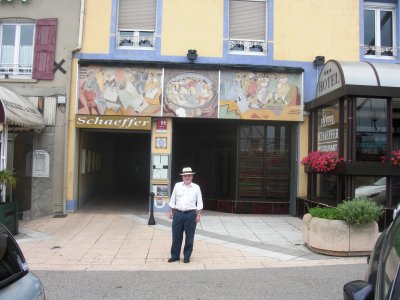
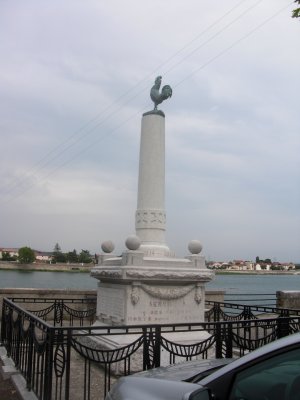 On the way south, we soon passed from Isère into the Département de l'Ardèche, and for long stretches, grape vines gave way to orchards. The number of dark sweet cherries we saw on the tree staggers the imagination. In addition, we saw orchards of apricots, plums, peaches, and apples. All that I saw were pruned into the "gobelet" shape. So, for that matter, were many of the vines. I guess when tractors are out of the question, straight narrow rows become less important.
On the way south, we soon passed from Isère into the Département de l'Ardèche, and for long stretches, grape vines gave way to orchards. The number of dark sweet cherries we saw on the tree staggers the imagination. In addition, we saw orchards of apricots, plums, peaches, and apples. All that I saw were pruned into the "gobelet" shape. So, for that matter, were many of the vines. I guess when tractors are out of the question, straight narrow rows become less important.
Soon we came to our hotel, which was, as promised on the west bank, right at the end of a major bridge. Here, David is standing in front of the main entrance. We had dinner in the glassed in, round-topped room you can see the end of at the right side of the photo. We managed to show up just at noon, when the lunch service was in full swing and everyone was pretty busy, but as it happened, our room was ready, so the chef (kitchen, reception desk, and lobby were not quite one room, but pretty open-plan) hailed a junior waiter from the dining room to carry our bags up to the third floor. We then moved the car to a nearby parking lot—long narrow gravel lots ran between the road and the river for a ways on each side of the bridge. Just across the road from those were the hotel and other local businesses. Between the parking lot and the river was this WWI memorial, topped with a coq, symbolizing France.
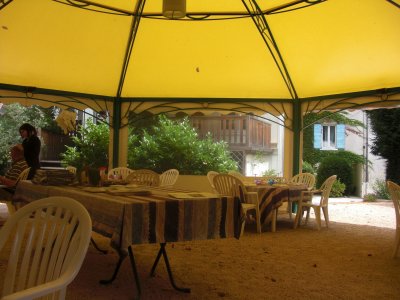
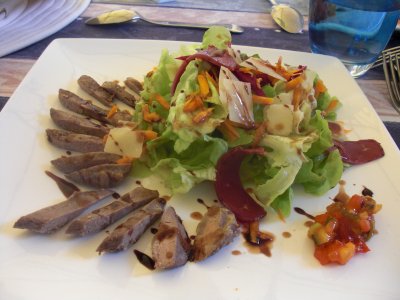 Because we would be eating at the hotel, we sought lunch elsewhere and wound up at the Restaurant du Parc. We followed the signs up a long narrow alley from the road and found the restaurant serving under a vast, open-sided tent that filled almost its entire courtyard. We and the only other customers, a party of four older people, were waited on by a lackadaisical, multiply pierced young woman. I had an okay salad surrounded by strips of cold, rather dry roast duck. I somehow failed to photograph David's lunch, and later neither of us could remember what it was, even after consulting the rather fragmentary menu posted on the place's website. Clearly no more memorable than my salad. We split quite a good crème brulée for dessert.
Because we would be eating at the hotel, we sought lunch elsewhere and wound up at the Restaurant du Parc. We followed the signs up a long narrow alley from the road and found the restaurant serving under a vast, open-sided tent that filled almost its entire courtyard. We and the only other customers, a party of four older people, were waited on by a lackadaisical, multiply pierced young woman. I had an okay salad surrounded by strips of cold, rather dry roast duck. I somehow failed to photograph David's lunch, and later neither of us could remember what it was, even after consulting the rather fragmentary menu posted on the place's website. Clearly no more memorable than my salad. We split quite a good crème brulée for dessert.
Back at the car, we reembarked on our driving tour of the wine-growing area, down the river to a convenient bridge (crossing it, we were welcomed to the Département du Drôme), then back up the east bank to the bridge leading to our hotel. Our time was limited, so we stuck mostly to the river bank rather than taking the detours up into the hills to visit the villages on the hilltops. In one town, we spotted this interesting castle, and we passed untold numbers of small wineries advertising tasting and sales, but mostly what we saw was vines and orchards, orchards and vines. Strangely, although the cherry trees everywhere were groaning under the weight of fat, black fruit, we never saw any being picked. The one in the photo was in somebody's back yard, so it was larger and had a higher proportion of leaves to fruit than the ones in the orchards.
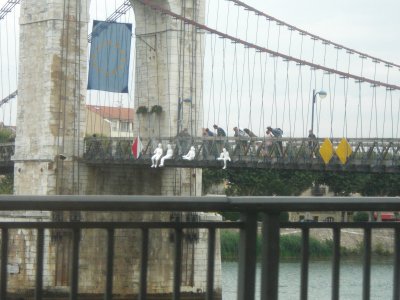
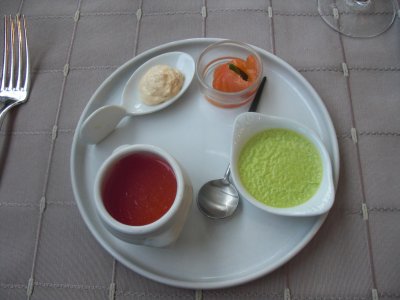 Back at the bridge to Serrières, we were amused to find these all-white (plaster?) "people" sitting on the edge, being closely examined by some real, living people standing safely behind the guard rail. From the hotel, they are hidden by the bridge tower, so we hadn't yet noticed them.
Back at the bridge to Serrières, we were amused to find these all-white (plaster?) "people" sitting on the edge, being closely examined by some real, living people standing safely behind the guard rail. From the hotel, they are hidden by the bridge tower, so we hadn't yet noticed them.
We were struck with what an active place the town seems to be. The circus (in the modern, not the ancient Roman, sense) was in town—its loud-speaker truck went by later in the day, doing its come-one-come-all thing. We drove by the midway, just gearing up for the evening, as we approached the bridge. Between there and the hotel we passed large banners advertising the upcoming Fête de la Moto (Motorcycle Festival, to be held 25-26 June) and the Festival of Beach Rugby (Sunday, 3 July). Happening sort of place.
Dinner that night was at the hotel, and we were seduced by the special tasting menu built around two "ingredients of the season": asparagus and morels. The amuse-bouche (shown above, to the right of the bridge) was fourfold: gazpacho of melon (a mixture of watermelon and canteloupe), flan of green onion, marinated salmon, and peanut mousse. The flan in particular was great! Then the asparagus and morels started coming . . .
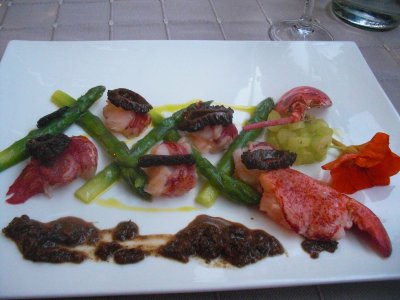
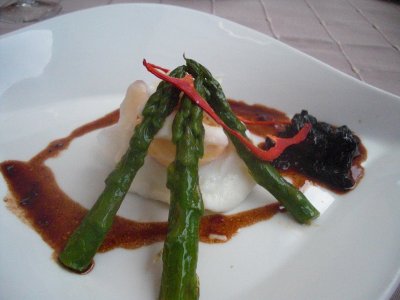 First course: Salad of lobster and small morels with salted purple asparagus and a "vinaigrette" of morel crumbs, crushed black olives, and olive oil. Like all of this chef's plates, it was beautiful! The bright orange object at the right-hand side is a nasturtium blossom (edible), and the cylinder of pale green objects is a heap of slices from the peeled stems of more asparagus.
First course: Salad of lobster and small morels with salted purple asparagus and a "vinaigrette" of morel crumbs, crushed black olives, and olive oil. Like all of this chef's plates, it was beautiful! The bright orange object at the right-hand side is a nasturtium blossom (edible), and the cylinder of pale green objects is a heap of slices from the peeled stems of more asparagus.
Second course: A poached hen's egg on a bed of risotto, minimorels marinated in balsamic vinegar, and slices of asparagus. The red garnish is a thin, dehydrated slice of sweet red pepper.
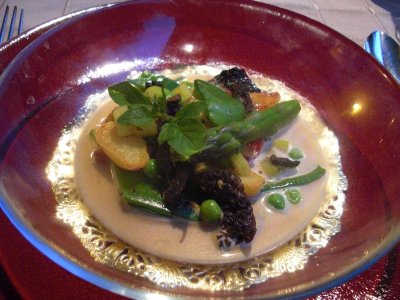
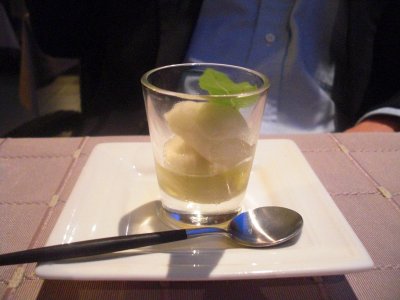 Third course: Baby gourmet potatoes and morels with green peas and asparagus in a tasty chicken sauce flavored with marjoram. A few other vegetables were thrown in, too. Delicous!
Third course: Baby gourmet potatoes and morels with green peas and asparagus in a tasty chicken sauce flavored with marjoram. A few other vegetables were thrown in, too. Delicous!
Palate cleanser: The "sorbet of the moment"— lime with mint, I think.
(Waiting between courses, we happened to look out through a narrow opening between a partially closed window blind and a parked car and spotted the chef's white-clad arm clipping herb sprigs from the planter you can see to the right of David right in the photo above. After dinner, we took a closer look, and yes, he's got at least six kinds of herbs growing in there, including the marjoram that showed up later in the meal.)
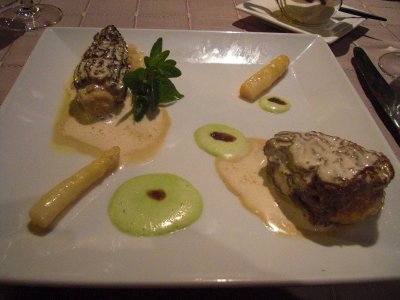
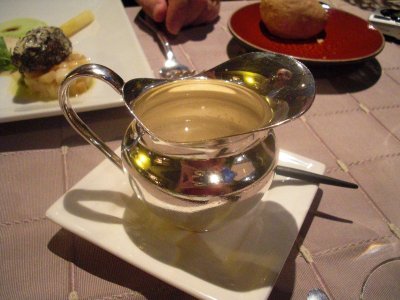
Fourth course: Two huge morels (by far the biggest I've ever seen), each stuffed with a mousse of chicken (morels are conical and hollow, an ideal shape for stuffing, but you almost never see any big enough to stuff with anything larger than an almond), accompanied by white asparagus and a rich morel cream sauce. Yum.
On the side was this graceful silver sauceboat filled with extra cream sauce, just in case the dish wasn't rich enough!
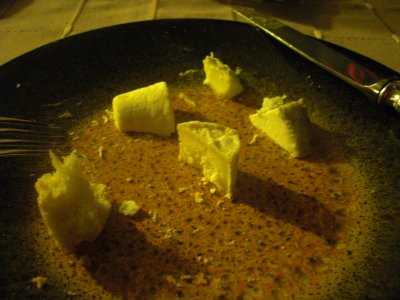
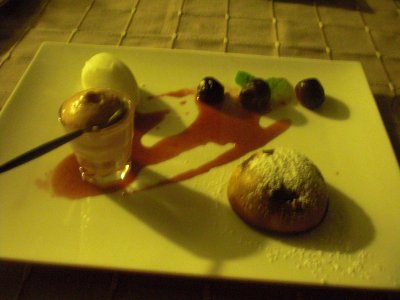 Cheese: I went for all chevre, all the time, from fresh and creamy to dry and chalky, some ashed and some not. All excellent.
Cheese: I went for all chevre, all the time, from fresh and creamy to dry and chalky, some ashed and some not. All excellent.
Dessert: Theme and variations on cherries—the only chef to offer this option, despite the whole region's being awash in fresh cherries. Three cherries poached in a lemon verbena flavored cherry syrup; a glass of cherry mousse; a small, dome-shaped cherry clafouti; and a quenelle of vanilla ice cream (perfect with the cherry syrup).
The next morning, we also found a bowl of fresh cherries on each breakfast table—a nice touch.
previous entry
List of Entries
next entry

 One of the things the tourist office had provided was a map of villages in the Côtes du Rhône wine area. As I've no doubt explained before, "côtes" in this sense means hillsides—the Côtes du Rhône are simply the hillsides facing the Rhône River from about Vienne to about Valence, mostly on the west side, but some on the east side as well. The whole region is therefore very long and skinny, and because Vienne and Serrières are both on the river, our route lay right along the route indicated on the map. We therefore fetched the car from the parking garage, packed it up, and commenced sight-seeing southward.
One of the things the tourist office had provided was a map of villages in the Côtes du Rhône wine area. As I've no doubt explained before, "côtes" in this sense means hillsides—the Côtes du Rhône are simply the hillsides facing the Rhône River from about Vienne to about Valence, mostly on the west side, but some on the east side as well. The whole region is therefore very long and skinny, and because Vienne and Serrières are both on the river, our route lay right along the route indicated on the map. We therefore fetched the car from the parking garage, packed it up, and commenced sight-seeing southward.
 On the way south, we soon passed from Isère into the Département de l'Ardèche, and for long stretches, grape vines gave way to orchards. The number of dark sweet cherries we saw on the tree staggers the imagination. In addition, we saw orchards of apricots, plums, peaches, and apples. All that I saw were pruned into the "gobelet" shape. So, for that matter, were many of the vines. I guess when tractors are out of the question, straight narrow rows become less important.
On the way south, we soon passed from Isère into the Département de l'Ardèche, and for long stretches, grape vines gave way to orchards. The number of dark sweet cherries we saw on the tree staggers the imagination. In addition, we saw orchards of apricots, plums, peaches, and apples. All that I saw were pruned into the "gobelet" shape. So, for that matter, were many of the vines. I guess when tractors are out of the question, straight narrow rows become less important.
 Because we would be eating at the hotel, we sought lunch elsewhere and wound up at the Restaurant du Parc. We followed the signs up a long narrow alley from the road and found the restaurant serving under a vast, open-sided tent that filled almost its entire courtyard. We and the only other customers, a party of four older people, were waited on by a lackadaisical, multiply pierced young woman. I had an okay salad surrounded by strips of cold, rather dry roast duck. I somehow failed to photograph David's lunch, and later neither of us could remember what it was, even after consulting the rather fragmentary menu posted on the place's website. Clearly no more memorable than my salad. We split quite a good crème brulée for dessert.
Because we would be eating at the hotel, we sought lunch elsewhere and wound up at the Restaurant du Parc. We followed the signs up a long narrow alley from the road and found the restaurant serving under a vast, open-sided tent that filled almost its entire courtyard. We and the only other customers, a party of four older people, were waited on by a lackadaisical, multiply pierced young woman. I had an okay salad surrounded by strips of cold, rather dry roast duck. I somehow failed to photograph David's lunch, and later neither of us could remember what it was, even after consulting the rather fragmentary menu posted on the place's website. Clearly no more memorable than my salad. We split quite a good crème brulée for dessert.
 Back at the bridge to Serrières, we were amused to find these all-white (plaster?) "people" sitting on the edge, being closely examined by some real, living people standing safely behind the guard rail. From the hotel, they are hidden by the bridge tower, so we hadn't yet noticed them.
Back at the bridge to Serrières, we were amused to find these all-white (plaster?) "people" sitting on the edge, being closely examined by some real, living people standing safely behind the guard rail. From the hotel, they are hidden by the bridge tower, so we hadn't yet noticed them. 
 First course: Salad of lobster and small morels with salted purple asparagus and a "vinaigrette" of morel crumbs, crushed black olives, and olive oil. Like all of this chef's plates, it was beautiful! The bright orange object at the right-hand side is a nasturtium blossom (edible), and the cylinder of pale green objects is a heap of slices from the peeled stems of more asparagus.
First course: Salad of lobster and small morels with salted purple asparagus and a "vinaigrette" of morel crumbs, crushed black olives, and olive oil. Like all of this chef's plates, it was beautiful! The bright orange object at the right-hand side is a nasturtium blossom (edible), and the cylinder of pale green objects is a heap of slices from the peeled stems of more asparagus.
 Third course: Baby gourmet potatoes and morels with green peas and asparagus in a tasty chicken sauce flavored with marjoram. A few other vegetables were thrown in, too. Delicous!
Third course: Baby gourmet potatoes and morels with green peas and asparagus in a tasty chicken sauce flavored with marjoram. A few other vegetables were thrown in, too. Delicous!


 Cheese: I went for all chevre, all the time, from fresh and creamy to dry and chalky, some ashed and some not. All excellent.
Cheese: I went for all chevre, all the time, from fresh and creamy to dry and chalky, some ashed and some not. All excellent.